Or at least a Pilgrim’s Progress” of variable intensity.In the eighteenth-century, there were many great importunate questions that sent pens scratching across an infinity of pages. And for these great minds of the enlightenment, above the din and controversy of debate, the clash of minds and philosophies, the febrile interchange from country to country, there was no question more importunate, none more fascinating, than this: Was America a mistake? Was it a mistake to have discovered the strange new world? A mistake to have conquered it? a mistake to plant colonies on its alien shores?
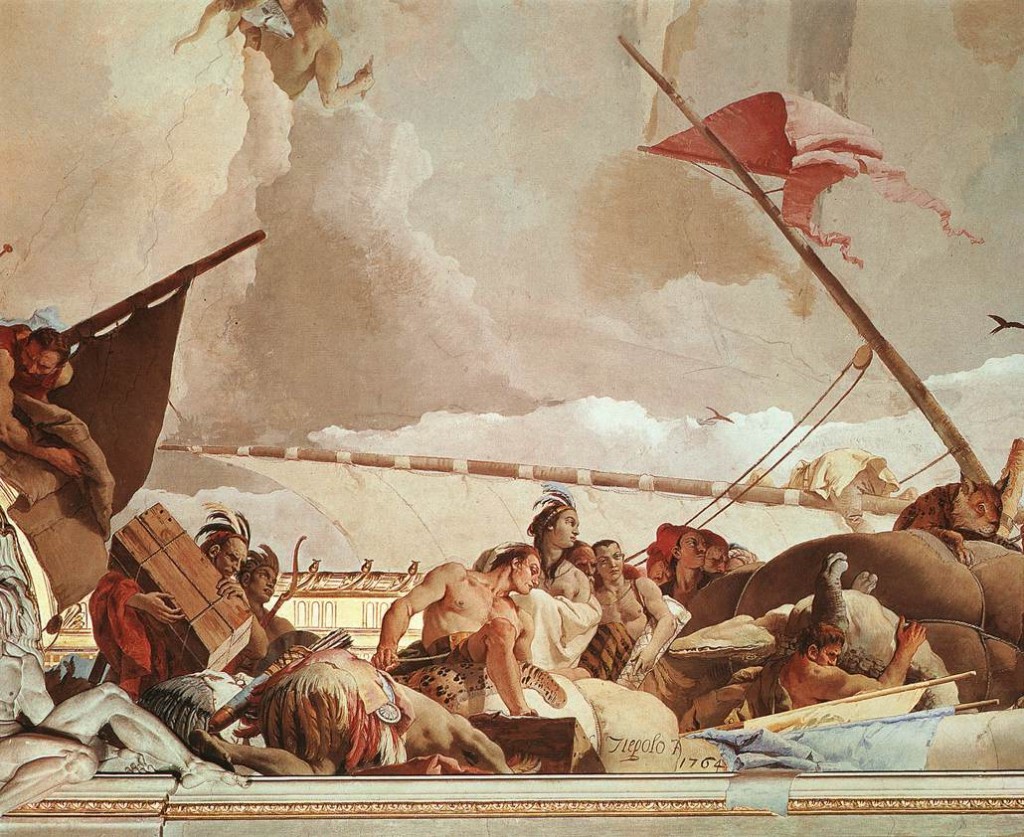
Giovanni Battista Tiepolo. Glory of Spain. 1762-66. ''The loading of a European ship with the treasures of the American continent is depicted in a direct allusion to the discovery of America by Christopher Columbus and to the Spanish conquest of the New World in the l6th century. The two Red Indians in the foreground, who throw themselves to the ground in front of the ship, symbolize the Europeans' victory over the natives.''
Everywhere the philosophers debated the question, but nowhere more insistently than in France. And not the philosophers only, but scientists and statesmen and churchmen as well; they were all philosophers to be sure. It was the Frenchman Abbe Raynal who brought it all to a head. Raynal was an extraordinary figure, prancing across the stage of Europe at mid-century, yet another of those abbes who are so ubiquitous in the period, another child of the Jesuits in revolt against that order. He was a preacher, at least for a time, a teacher, and a man of letters. He was an economist, philosopher, historian and even a patron of the arts. Somewhere along the way, his critics said in the slave trade, he had picked up a fortune, and he dispensed it with a free hand; here a literary prize, there a subsidy to one of the academies that had honored him with membership, here support to the young Provencals who flocked about him in Paris, there, it happened to be on an island in the Lake of Lucerne, a statue to Liberty in the likeness of none other than the Abbe Raynal himself.
He was not a great man, far from it; but he wrote one of the great books of the age titled ”A Philosophical and Political History of the Settlements and Trade of the Europeans in the East and West Indies”. That ”History” was in its day, a weapon, a force and an institution. The work first appeared in 1770 in four large volumes, then in eight, and eventually in twelve. It went through edition after edition including twenty authorized and forty or fifty more that were pirated.
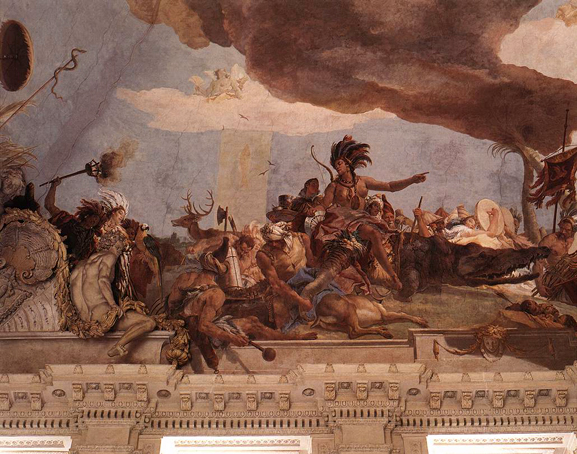
''The personification of the American Continent rides on a huge crocodile. With her naked upper torso and feathered head-dress, she represents the uncivilized world. She is surrounded by people characterized as wild creatures, who hunt with bow and arrow. The figure reclining below her holds a horn of plenty as a symbol of the riches and fertility of this part of the world, which was of the greatest interest to the Europeans.''
Benjamin Franklin read it and was amused by it and provided materials that would modify its excesses; Jefferson read it and was moved to reply in his ”Notes on Virginia”. Gibbon read it and admired it, and so did his rival, William Robertson, up in Edinburgh. Frederick the Great read it with enthusiasm until he came to an outrageous criticism of his wars, and then he threw it in the fire. In Paris, Baron von Grimm and wrote, ”Since Montesquieu, our literature has produced no monument that is worthier to pass to the remotest posterity, and to consecrate the progress of our enlightenment.” That was it. Raynal’s book was to consecrate the progress of the Enlightenment.
The book was a history of sorts; a potpourri of history, economics, politics, anthropology, and morality, written every which way and by half a dozen contributors, though Raynal saw to it that he got all the credit. It was the first history to deal with the expansion of Europe as a single grand theme, the first to do justice to different races, and the first to fit together politics and economics and religion and society in a single pattern. It preached the immorality of war and the iniquity of colonies and the betrayal of religion by the church and the right of revolution and the virtue of simplicity in contrast to the wickedness of sophistication.
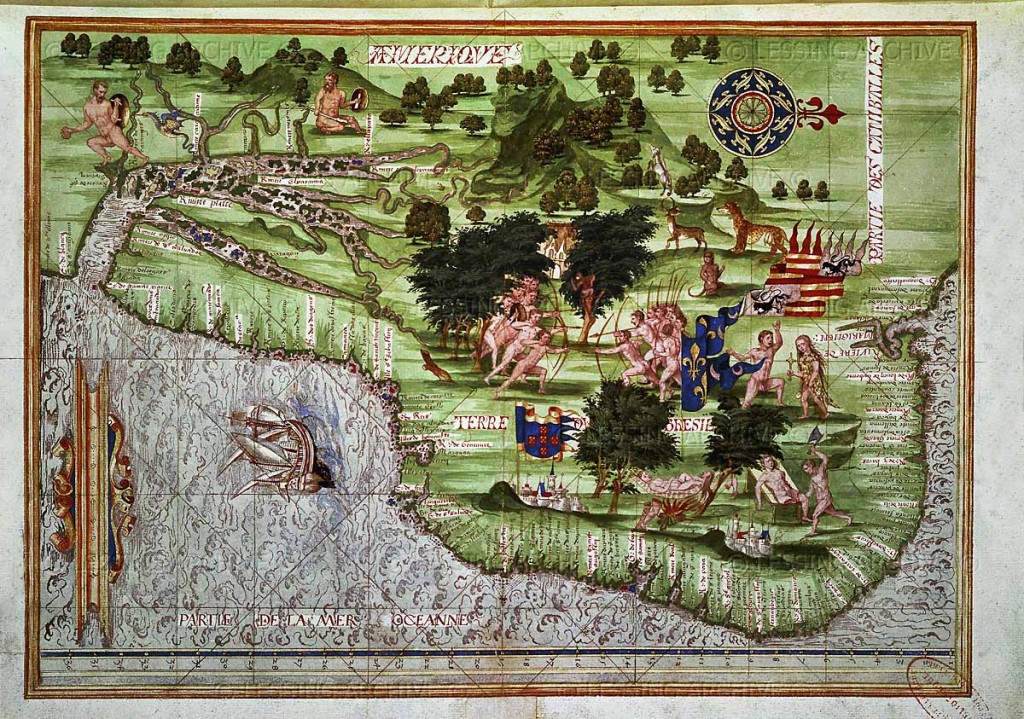
By the middle of the sixteenth-century, reports of cannibalism among the Indians began to clash severely with philosophical notions of the noble savage. Guillaume le Testu avoided the problem with this 1555 map of Brasil by showing both the idyllic and the savage in a bewildering blend. Adam and Eve like, the Brazilians sleep blissfully in hammocks, and at the same time practice butchery upon each other.
If Raynal’s book was not ”against all governments and religions”, as Horace Walpole wrote, it was certainly against the governments of those powers that had so wickedly exploited the two Indies. If it was not against all religion, it was certainly against the religion preached by the Jesuits to the Chinese and the Paraguayans and the Huron Indians. No wonder the book was anathema to the authorities of France; no wonder it was put on the Index, banned and burned; no wonder it was read with rapture in every country in Europe.
An what was the message that Europe read in this flaming, explosive history? Essentially, it was that wherever Europeans had gone, in the East or in the West, they had carried death, disease, and destruction. They had created empires, but at the price of senseless wars and of the lives of millions of innocent natives. Not since the deluge had there been such desolation. They had added undreamed of luxuries of life, and had enervated those who indulged in them. They had spread commerce but inflamed speculation, and had substituted the love of gold for the love of honor. They had spread Christianity and with it supersitition and fanaticism. Worst of all, their religion had fastened slavery on half the globe.
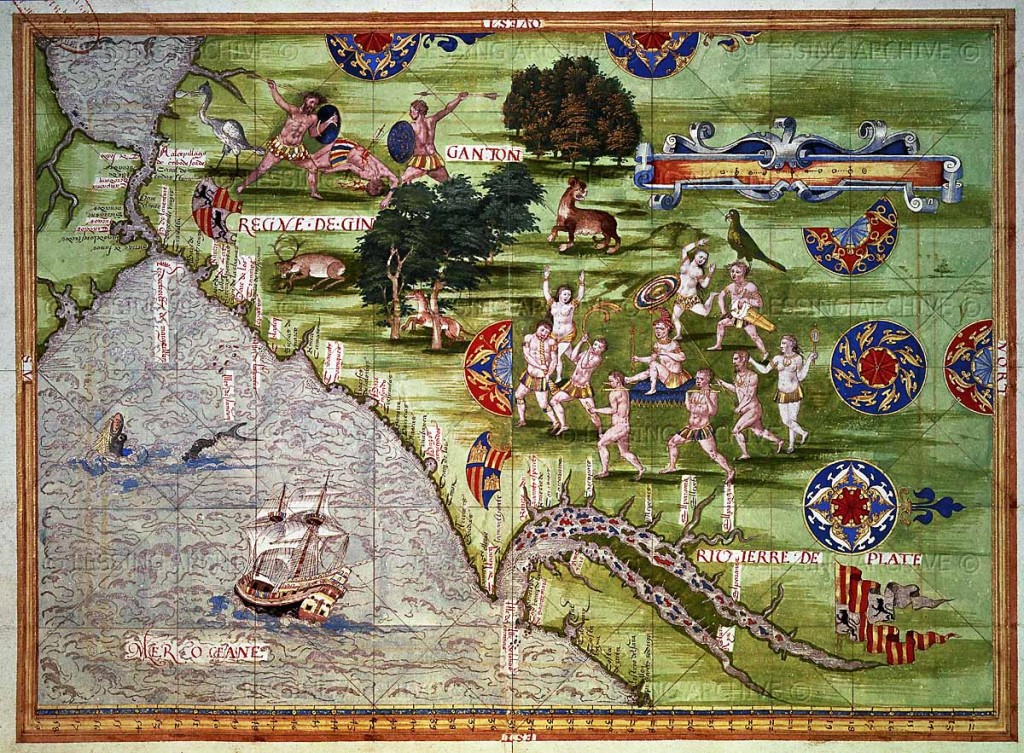
RENAISSANCE MAPS, GEOGRAPHIC 16TH Cosmographie Universelle by Guillaume Le Testu,1555. Rio de la Plata and the Atlantic Ocean.Fol.43 verso.
American natives dancing. Service Historique de l'Armee de Terre, Vincennes, FranceThe discovery of America was worse than a sin. It was a mistake. How much better for mankind had America remained hidden in that oblivion to which a kind nature had consigned her. For the American continents were primitive, degenerate and irremediable. Everything in the New World, Raynal wrote, ”exhibits the vestiges of a malady of which the human race still feels the effects. The ruin of that world is still imprinted on its inhabitants, they art a species of men degraded and degenerated in their natural constitution, in their stature, in their way of life, and in their understanding, which is but little advanced in all the arts of civilization. A damper air and a more marshy ground must necessarily have infected the very roots and seeds both of the subsistence and the multiplication of mankind”. And on slavery:
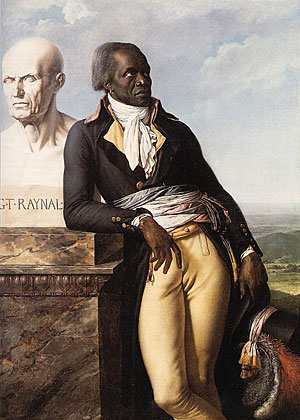
''1797 portrait of Jean-Baptiste Belley. Born in Senegal and enslaved in Santo Domingo (Haiti), Belley went on to be one of the Haitian delegates to the French National Convention, which abolished slavery in 1794. In 1802, he fought with Toussaint L'Ouverture and, as a consequence, died in a French prison in 1802. The bust is the painting is Abbé Raynal, a noted abolitionist.''
”But it is urged, that in Europe, as well as in America, the people are slaves. The only advantage we have over the Negroes is, that we can break one chain to put on another.
It is but too true; most nations are enslaved. The multitude is generally sacrificed to the passions of a few privileged oppressors. There is scarce a region know’n, where a man can flatter himself that he is master of his person, that he can dispose, at pleasure, of his inheritance; and that he can quietly enjoy the fruits of his industry. Even in those countries that are least under the yoke of servitude, the citizen deprived of the produce of his labor, by the wants incessantly renewed of a rapacious or needy government, is continually restrained in the most lawful means of acquiring felicity. Liberty is stifled in all parts, by extravagant superstitions, by barbarous customs, and by obsolete laws. It will one day certainly rise again from it’s ashes. In proportion as morality and policy shall be improved, man will recover his rights. But wherefore, while we are waiting for these fortunate times, and these enlightened ages of prosperity wherefore must there be an unfortunate race, to whom even the comfortable and honorable name of freeman is denied, and who, notwithstanding the instability of events, must be deprived of the hope even of obtaining it?”
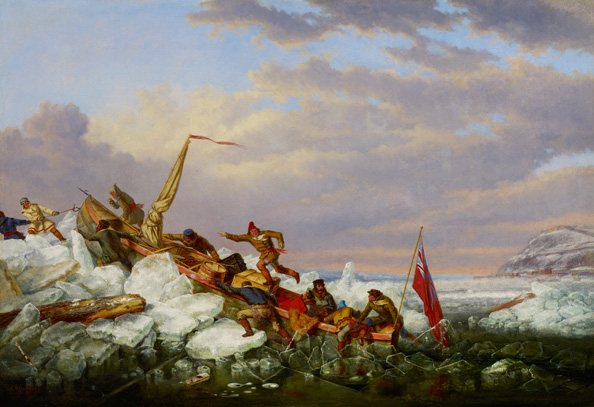
Cornelius Krieghoff born Amsterdam, The Netherlands, 1815; died Chicago, Illinois, United States, 1872 Mail Boat Landing at Quebec 1860 oil on canvas 42.5 x 62.0 cm The Thomson Collection © Art Gallery of Ontario
Nature was corrupt, animal life feeble, and as for the savages who roamed the jungles and swamps and deserts, ”they have less appearance of manhood, and are but little susceptible of the lively and powerful sentiment of love”. And, ”Men who have little more beard than eunichs have, cannot abound in generating principles. The blood of these people is watery and cold; the males have sometimes milk in their breasts. Hence arises their tardy inclination to the sex…Hence …hath proceeded that want of population which hath always been observed in them.”
It was not just the savages of America who were doomed by Nature to inferiority; it was the Europeans as well. Clearly, Spain was on the decline, in the Old World and in the New. The Creoles of Louisiana were enervated in mind as in body. Even the English, this was in the earlier editions, ”had visibly degenerated”. Had Nature punished them for colonizing in this unwelcome world?

''Sea Captains Carousing in Surinam (c1752-1758) by John Greenwood (1727-1792) courtesy St. Louis Art Museum. Left to right at table: Nicholas Cooke, Esek Hopkins, Stephen Hopkins (asleep), and Joseph Wanton. Click to view entire image. There is some controversy as to whether this man in red was actually Stephen Hopkins, as per the said tradition of the original owners of the painting, the Jenckes family. Brown University professor Robert Kenney believed that this man must have been Esek and Stephen's other brother, William, since Stephen was at the time running for re-election as Governor, and tied up in court in Worcester MA while suing his arch rival Samuel Ward for slander.''
The conclusion of this elaborate investigation was harsh but inescapable: The discovery of America had been a mistake. Far better had Columbus never lifted the veil that had so long hidden this world from the greedy eyes of the East; far better had the conquistadors failed in their campaigns against the Aztecs and the Incas; far better had Cabot and Verrazano and Henry Hudson and all the other intrepid navigators found a watery grave in those oceans that had so long guarded the Western World.





 COMMENTS
COMMENTS
Of historical interest — You can see a clip of Toussaint’s last moments in prison from the award-winning new short film “The Last Days of Toussaint L’Ouverture” at http://www.imdb.com/name/nm2468184/